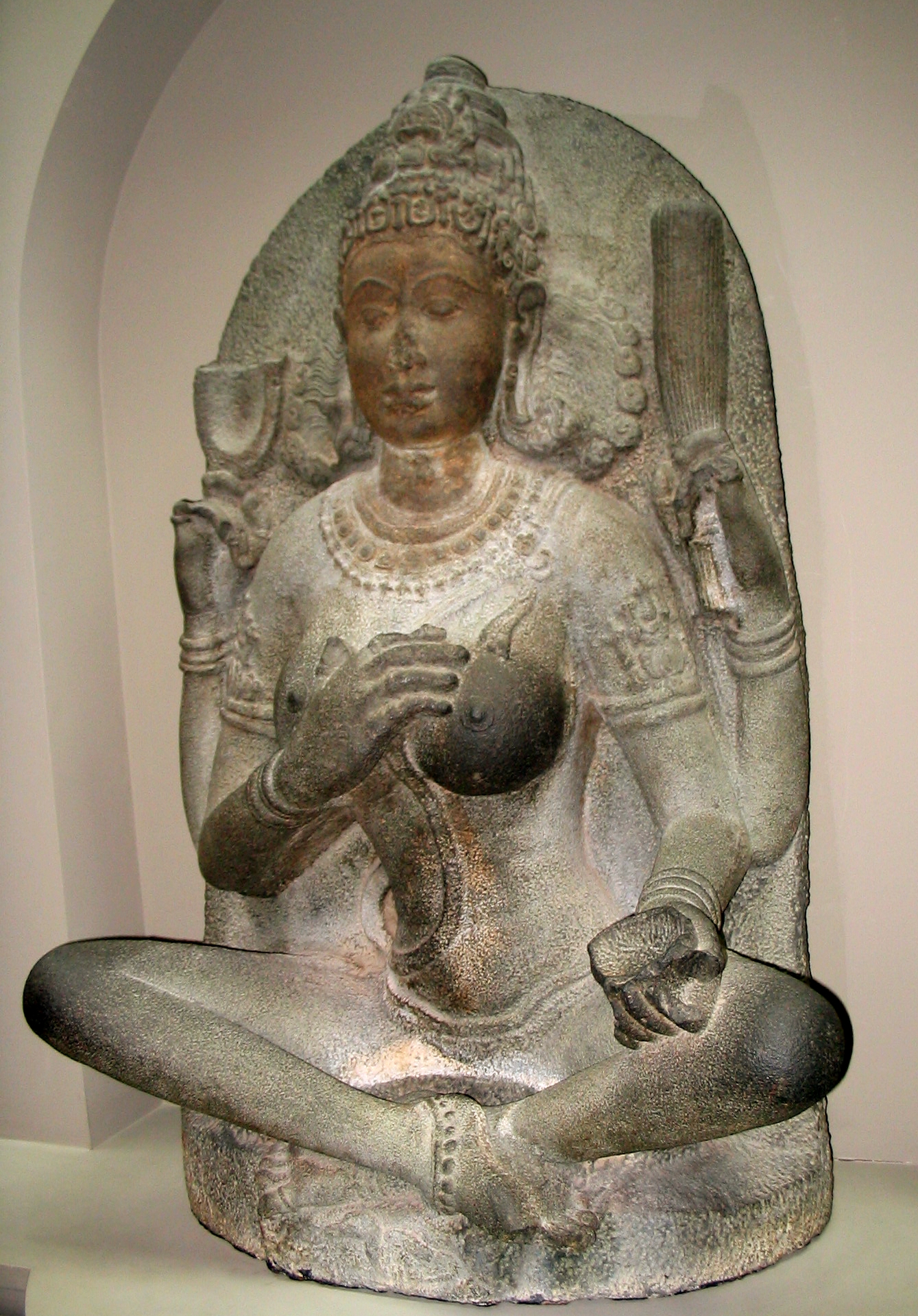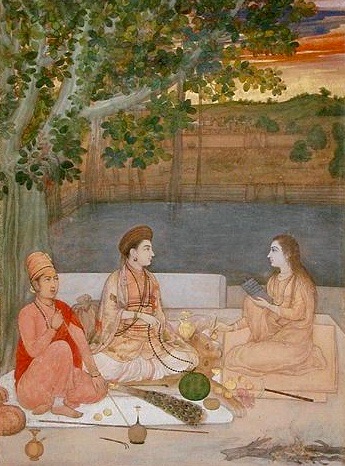|
Yogin
A yogi is a practitioner of Yoga, including a sannyasin or practitioner of meditation in Indian religions.A. K. Banerjea (2014), ''Philosophy of Gorakhnath with Goraksha-Vacana-Sangraha'', Motilal Banarsidass, , pp. xxiii, 297-299, 331 The feminine form, sometimes used in English, is yogini. Yogi has since the 12th century CE also denoted members of the Nath siddha tradition of Hinduism, and in Hinduism, Buddhism and Jainism, a practitioner of tantra.Rita Gross (1993), ''Buddhism After Patriarchy'', SUNY Press, , pages 85–88 In Hindu mythology, the god Shiva and the goddess Parvati are depicted as an emblematic yogi–yogini pair. Etymology In Classical Sanskrit, the word ''yogi'' (Sanskrit: masc ', योगी; fem ') is derived from ''yogin'', which refers to a practitioner of yoga. ''Yogi'' is technically male, and ''yoginī'' is the term used for female practitioners. The two terms are still used with those meanings today, but the word ''yogi'' is also used gen ... [...More Info...] [...Related Items...] OR: [Wikipedia] [Google] [Baidu] |
Yogini
A yogini (Sanskrit: योगिनी, IAST: ) is a female master practitioner of tantra and yoga, as well as a formal term of respect for female Hindu or Buddhist spiritual teachers in Indian subcontinent, Southeast Asia and Greater Tibet. The term is the feminine Sanskrit word of the masculine ''yogi'', while the term "yogin" is used in neutral, masculine or feminine sense. A yogini, in some contexts, is the sacred feminine force made incarnate, as an aspect of Parvati, and revered in the yogini temples of India as the Sixty-four Yoginis. History The worship of yoginis began outside Vedic Religion, starting according to Vidya Dehejia with the cults of local village goddesses, the ''grama devatas''. Each one protects her village, sometimes giving specific benefits such as safety from the stings of scorpions. Gradually, through Tantra, these goddesses were grouped together into a number believed powerful, most often 64, and they became accepted as a valid part of Hinduism. ... [...More Info...] [...Related Items...] OR: [Wikipedia] [Google] [Baidu] |
Tantra
Tantra (; sa, तन्त्र, lit=loom, weave, warp) are the esoteric traditions of Hinduism and Buddhism that developed on the Indian subcontinent from the middle of the 1st millennium CE onwards. The term ''tantra'', in the Indian traditions, also means any systematic broadly applicable "text, theory, system, method, instrument, technique or practice". A key feature of these traditions is the use of mantras, and thus they are commonly referred to as Mantramārga ("Path of Mantra") in Hinduism or Mantrayāna ("Mantra Vehicle") and Guhyamantra ("Secret Mantra") in Buddhism. Starting in the early centuries of the common era, newly revealed Tantras centering on Vishnu, Shiva or Shakti emerged. There are tantric lineages in all main forms of modern Hinduism, such as the Shaiva Siddhanta tradition, the Shakta sect of Sri-Vidya, the Kaula, and Kashmir Shaivism. In Buddhism, the Vajrayana traditions are known for tantric ideas and practices, which are based on India ... [...More Info...] [...Related Items...] OR: [Wikipedia] [Google] [Baidu] |
Shaivism
Shaivism (; sa, शैवसम्प्रदायः, Śaivasampradāyaḥ) is one of the major Hindu traditions, which worships Shiva as the Supreme Being. One of the largest Hindu denominations, it incorporates many sub-traditions ranging from devotional dualistic theism such as Shaiva Siddhanta to yoga-orientated monistic non-theism such as Kashmiri Shaivism.Ganesh Tagare (2002), The Pratyabhijñā Philosophy, Motilal Banarsidass, , pages 16–19 It considers both the Vedas and the Agama texts as important sources of theology.Mariasusai Dhavamony (1999), Hindu Spirituality, Gregorian University and Biblical Press, , pages 31–34 with footnotesMark Dyczkowski (1989), The Canon of the Śaivāgama, Motilal Banarsidass, , pages 43–44 Shaivism developed as an amalgam of pre-Vedic religions and traditions derived from the southern Tamil Shaiva Siddhanta traditions and philosophies, which were assimilated in the non-Vedic Shiva-tradition. In the process of Sanskritisa ... [...More Info...] [...Related Items...] OR: [Wikipedia] [Google] [Baidu] |
David Gordon White
David Gordon White (born September 3, 1953) is an American Indologist. Academic career David Gordon White took his B.A. in South Asian Studies at the University of Wisconsin in 1975. He obtained an M.A. in Religion at the University of Chicago in 1981 and his Ph.D. in the history of religions there in 1988; his dissertation was titled ''The Other Gives Rise to Self: Dog-Men on the Borders of Medieval Europe, India, and China''. He served as an assistant to Mircea Eliade. He is the J. F. Rowny Professor of Comparative Religion at the University of California, Santa Barbara, where he has been teaching since 1996. He has written numerous academic books and papers on the history of yoga. Honors and distinctions White won the CHOICE book selection in religion, and an honorable mention in the PROSE book awards, both for ''Sinister Yogis''. Reception British indologist James Mallinson, recognising that White's "wide-ranging scholarship on tantra, yoga and alchemy has inspired many s ... [...More Info...] [...Related Items...] OR: [Wikipedia] [Google] [Baidu] |
Yoga
Yoga (; sa, योग, lit=yoke' or 'union ) is a group of physical, mental, and spiritual practices or disciplines which originated in ancient India and aim to control (yoke) and still the mind, recognizing a detached witness-consciousness untouched by the mind ('' Chitta'') and mundane suffering (''Duḥkha''). There is a wide variety of schools of yoga, practices, and goals in Hinduism, Buddhism, and Jainism,Stuart Ray Sarbacker, ''Samādhi: The Numinous and Cessative in Indo-Tibetan Yoga''. SUNY Press, 2005, pp. 1–2.Tattvarthasutra .1 see Manu Doshi (2007) Translation of Tattvarthasutra, Ahmedabad: Shrut Ratnakar p. 102. and traditional and modern yoga is practiced worldwide. Two general theories exist on the origins of yoga. The linear model holds that yoga originated in the Vedic period, as reflected in the Vedic textual corpus, and influenced Buddhism; according to author Edward Fitzpatrick Crangle, this model is mainly supported by Hindu scholars. According ... [...More Info...] [...Related Items...] OR: [Wikipedia] [Google] [Baidu] |
Yoga
Yoga (; sa, योग, lit=yoke' or 'union ) is a group of physical, mental, and spiritual practices or disciplines which originated in ancient India and aim to control (yoke) and still the mind, recognizing a detached witness-consciousness untouched by the mind ('' Chitta'') and mundane suffering (''Duḥkha''). There is a wide variety of schools of yoga, practices, and goals in Hinduism, Buddhism, and Jainism,Stuart Ray Sarbacker, ''Samādhi: The Numinous and Cessative in Indo-Tibetan Yoga''. SUNY Press, 2005, pp. 1–2.Tattvarthasutra .1 see Manu Doshi (2007) Translation of Tattvarthasutra, Ahmedabad: Shrut Ratnakar p. 102. and traditional and modern yoga is practiced worldwide. Two general theories exist on the origins of yoga. The linear model holds that yoga originated in the Vedic period, as reflected in the Vedic textual corpus, and influenced Buddhism; according to author Edward Fitzpatrick Crangle, this model is mainly supported by Hindu scholars. According ... [...More Info...] [...Related Items...] OR: [Wikipedia] [Google] [Baidu] |
Sannyasa
''Sannyasa'' (Sanskrit: संन्यास; IAST: ), sometimes spelled Sanyasa (सन्न्यास) or Sanyasi (for the person), is life of renunciation and the fourth stage within the Hindu system of four life stages known as '' Ashramas'', with the first three being Brahmacharya (bachelor student), Grihastha (householder) and Vanaprastha (forest dweller, retired). Sannyasa is traditionally conceptualized for men or women in late years of their life, but young brahmacharis have had the choice to skip the householder and retirement stages, renounce worldly and materialistic pursuits and dedicate their lives to spiritual pursuits. Sannyasa is a form of asceticism, is marked by renunciation of material desires and prejudices, represented by a state of disinterest and detachment from material life, and has the purpose of spending one's life in peaceful, spiritual pursuits. An individual in Sanyasa is known as a ''Sannyasi'' (male) or ''Sannyasini'' (female) in Hinduis ... [...More Info...] [...Related Items...] OR: [Wikipedia] [Google] [Baidu] |
Asceticism
Asceticism (; from the el, ἄσκησις, áskesis, exercise', 'training) is a lifestyle characterized by abstinence from sensual pleasures, often for the purpose of pursuing spiritual goals. Ascetics may withdraw from the world for their practices or continue to be part of their society, but typically adopt a frugal lifestyle, characterised by the renunciation of material possessions and physical pleasures, and also spend time fasting while concentrating on the practice of religion or reflection upon spiritual matters. Various individuals have also attempted an ascetic lifestyle to free themselves from addictions, some of them particular to modern life, such as money, alcohol, tobacco, drugs, entertainment, sex, food, etc. Asceticism has been historically observed in many religious traditions, including Buddhism, Jainism, Hinduism, Islam, Christianity, Judaism, Stoicism and Pythagoreanism and contemporary practices continue amongst some religious followers. The practiti ... [...More Info...] [...Related Items...] OR: [Wikipedia] [Google] [Baidu] |
Vaishnavism
Vaishnavism ( sa, वैष्णवसम्प्रदायः, Vaiṣṇavasampradāyaḥ) is one of the major Hindu denominations along with Shaivism, Shaktism, and Smartism. It is also called Vishnuism since it considers Vishnu as the sole Para Brahman, supreme being leading all other Hindu deities, i.e. ''Mahavishnu''. Its followers are called Vaishnavites or ''Vaishnava''s (), and it includes sub-sects like Krishnaism and Ramaism, which consider Krishna and Rama as the supreme beings respectively. According to a 2010 estimate by Johnson and Grim, Vaishnavism is the largest Hindu sect, constituting about 641 million or 67.6% of Hindus. The ancient emergence of Vaishnavism is unclear, and broadly hypothesized as a History of Hinduism, fusion of various regional non-Vedic religions with Vishnu. A merger of several popular non-Vedic theistic traditions, particularly the Bhagavata cults of Vāsudeva, Vāsudeva-krishna and ''Gopala-Krishna, Gopala-Krishna'', and Narayana, ... [...More Info...] [...Related Items...] OR: [Wikipedia] [Google] [Baidu] |
Shiva
Shiva (; sa, शिव, lit=The Auspicious One, Śiva ), also known as Mahadeva (; ɐɦaːd̪eːʋɐ, or Hara, is one of the principal deities of Hinduism. He is the Supreme Being in Shaivism, one of the major traditions within Hinduism. Shiva is known as "The Destroyer" within the Trimurti, the Hindu trinity which also includes Brahma and Vishnu. In the Shaivite tradition, Shiva is the Supreme Lord who creates, protects and transforms the universe. In the goddess-oriented Shakta tradition, the Supreme Goddess ( Devi) is regarded as the energy and creative power (Shakti) and the equal complementary partner of Shiva. Shiva is one of the five equivalent deities in Panchayatana puja of the Smarta tradition of Hinduism. Shiva has many aspects, benevolent as well as fearsome. In benevolent aspects, he is depicted as an omniscient Yogi who lives an ascetic life on Mount Kailash as well as a householder with his wife Parvati and his three children, Ganesha, Kartikeya and A ... [...More Info...] [...Related Items...] OR: [Wikipedia] [Google] [Baidu] |
Nath
Nath, also called Natha, are a Shaiva sub-tradition within Hinduism in India and Nepal. A medieval movement, it combined ideas from Buddhism, Shaivism and Yoga traditions in India.Natha: Indian religious sect Encyclopedia Britannica (2007) The Naths have been a confederation of devotees who consider , as their first lord or , with varying lists of additional gurus. Of these, the 9th or 10th century |
Hinduism
Hinduism () is an Indian religion or '' dharma'', a religious and universal order or way of life by which followers abide. As a religion, it is the world's third-largest, with over 1.2–1.35 billion followers, or 15–16% of the global population, known as Hindus. The word ''Hindu'' is an exonym, and while Hinduism has been called the oldest religion in the world, many practitioners refer to their religion as '' Sanātana Dharma'' ( sa, सनातन धर्म, lit='the Eternal Dharma'), a modern usage, which refers to the idea that its origins lie beyond human history, as revealed in the Hindu texts. Another endonym is ''Vaidika dharma'', the dharma related to the Vedas. Hinduism is a diverse system of thought marked by a range of philosophies and shared concepts, rituals, cosmological systems, pilgrimage sites, and shared textual sources that discuss theology, metaphysics, mythology, Vedic yajna, yoga, agamic rituals, and temple building, among other to ... [...More Info...] [...Related Items...] OR: [Wikipedia] [Google] [Baidu] |










